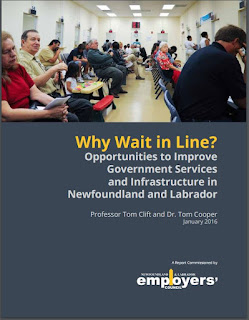Provincial Government proceeds with Public Private Partnerships (P3s) and
Alternative Service Delivery (ASD) models to provide infrastructure and
services, the public will need to understand this approach is not risk-free.
might that risk be? It is that the returns from P3s will reflect the worst of
what the public service and the private sector, combined, have to offer.
begin with, the suitability of the P3 service model should not be defined
either by NAPE or by the NL Employers Council, who are on opposite sides of the
issue.
 |
| NAPE President Gerry Earle |
NAPE is
concerned that government will diminish its size, which is already under threat.
It doesn’t fret about bloat or that the bureaucracy has been diminished by a bevy of overpaid consultants who rob them
of opportunity and advancement. NAPE should be the biggest booster of a stronger
Public Service Commission, but it isn’t.
NLEC is preoccupied with growing new private sector opportunities for its membership;
a group that, by now, should be wondering if they have anything to offer, having
mindlessly chosen to boost, some by their silence, the worst state-owned
enterprise idea imaginable, the Muskrat legacy project.
A Study
conducted for the NLEC, entitled WHY WAIT IN LINE? by Professor Tom Clift and
Dr. Tom Cooper, indicates the authors have thought about government readiness.
That is a hopeful sign, because it means government might get more reminding.
 |
| NLEC Executive Director Richard Alexander |
Public-Private Partnerships were once
thought merely a way to procure public infrastructure; buildings, roads, and
bridges, without increasing balance sheet debt. They employ a “design build”
model; one relatively simple, when the rules are clear, and access to open
competition is assured.
used to finance and manage a plethora of services from senior citizens homes to
hospitals and even prisons; both the infrastructure and its operational purpose.
This is a far more complicated model; one that is given caution by Messers.
Clift and Cooper, who propose a “step by step” approach because, as they state,
what has worked in other jurisdictions may not work here; though I think they are
chiefly, and sensibly, advising both business and government to ‘walk before
they can run’.
suitable to P3s are ones in which risks and rewards are most easily quantified,
such as: motor vehicle registration, low risk transactional health services, construction
& facility maintenance, diagnostic imaging, alcohol sales, IT, long term
care facilities, among others.
have to address its internal management capability, if the public interest is remains paramount.
share risk, financing, and deliver access to their management and logistical
skills.
essential underpinning of private capital is reward.
that private management, inspired by profit, can achieve this objective, perform
the service effectively, and give the “client” savings, too.
issue; even if it seems irreconcilable. This is, in part, because of the
absence of a reliable methodology for determining if P3s are worth the bother. Even
in the case of the simple “design-build model”, there are wide discrepancies as
to the appropriate premium for the “risk shouldered by the private partner…”,
as a Globe and Mail article noted.
highlighted by Ontario’s auditor-general”. That province has embraced P3s
to the tune of billions of dollars since the late 1990s. They include hospitals
and Toronto’s Highway 407.
those who are ideologically opposed to profit.
blogger, Hans Rollman writing for the Independent, took the gloves off last
week in an effort to discredit P3s. He
cited, as proof of their failure, a 31% increase in the cost of the Adult Basic
Education program, a decision by an Ontario Hospital Group to cancel
outsourcing medical equipment sterilization, and even a Report by the left
leaning Canadian Centre for Policy Alternatives.
Indeed, like P3s and exclusively government programs, there are losers among private companies, too. But the push towards P3s, especially in Ontario and B.C,. who have more than two decades of experience with P3 and ASD models, suggest they have a value worth mining.
see that the system, as it currently operates, is not working. They don’t
accept either, that the public service we now know will be unrecognizable in just a few years. It it is not sustainable.
That is one reason the private sector might have a a partnership role, if the balance of risk is not placed entirely on the Government.
and I emphasize might, have a place in public policy execution, anyway.
But there is good
reason for the qualification.
for example, should be a poster child for the professional public service. The department
has operated for decades on the periphery of the P3 concept, as government’s infrastructure
builder, and as administrator of the Public Tender Act. It relates to a bevy of
professionals in many disciplines, writes tender specifications, performs contract
administration, engineering, and most importantly, inspection functions.
be a beacon giving guidance to government, boasting rigid systems for management,
quality control, project schedules, and financial management. It should be a
font of skill and advice on how best to manage P3s.
and not just due to the Humber Valley Paving fiasco.
Valley High and Roncalli cover-ups in which students were placed at risk, and
oversight proven faulty. The steel skeleton of the new Virginia Park School has
already cost $12 million, due to botched management in the department; a
finished school, or something close, should be gotten for that amount.
call the “gift that keeps on giving” – to private contractors. Even a new asphalt
surface, properly installed, will never last because the road bed was incorrectly
built, in the first place.
are not replaced and inspections are curtailed. Neither does the system promote
a culture of independent oversight when “writing up” the contractor brings fear
of reprisal, and when there are no restrictions on key people, including
inspectors, working for the department one day, and for the contractor the next.
will oversee P3s, their failure will be swift and their cost to the public
purse significant.
Transportation and Works?
unacceptable. Government will never be more than a place of mediocrity unless rigorous
steps are taken to make the public service a fortress of transparency, thrift, diligence,
and professionalism.
which the private sector is let in, will give new urgency to the public service
to do better at what it is supposed to do best.
Their success is predicated on the private partner operating within clearly
defined agreements that set out quantifiable performance standards; a process that
also requires proper monitoring.
lest they are swallowed up by savvy, better motivated, better resourced, and
possibly better paid private partners.
mandatory. P3s, either in their original design and award, or operation, must
not be part of a political patronage system, as public works often are. In
other words, if the Government wants an unprepared and under resourced
bureaucracy to handle the public part of P3s, don’t even think about it. It
won’t work.
Cooper propose a governance structure and the “need to have an independent
entity within the government, akin to a function such as the Auditor General,
responsible for developing and implementing ASD and PPP models.
stronger than our “pussy cat” A-G. But, I get their point.
too?


In Newfoundland we are entering a society without precedent in the Western World. We will have a very senior population, with a declining tax base. We better get serious about alternative delivery models if we want to maintain the services we need. There is no benchmark… we are almost unique in this demographic timebomb.
There was so much we could have done from 2005 to 2015. We could have solved some problems with our oil wealth. Instead we have exasperated our biggest risks.
We were fortunate that our peak oil production coincided with peak oil prices. It was a windfall, unfotunately is was squandered by an inept government.
I have come to the conclusion that Newfoundlander's are incapable of governing ourselves.
What I don't get with P3's is why the unions cannon come on board and help the need disappear. That means working a solid work day, dropping some lucrative things that have been given such as 45 hour work weeks, too much sick time utilization etc. Fir management, doing with less of everything. All want windowed walked offices. Just do with less. If the private sector can build and operate at less cost why not civil service. I have no issue with retaining the government role but why us it more expensive (as folks claim)? With respect to the private folks they will risk out their P3's and gov't will likely carry but off books and thus out of sight. So me of it would be smoke and mirrors. Gov't can improve service at less cost in many areas I am convinced but leadership needs to be given the opportunity. As a first step take the politics out of the civil service. They have lots of great folks who would love the opportunity and would deliver.
Frankly I get nauseated at the arguments for and against. Each possibility needs an unbiased look, and cost based and strategic decisions made.
PS. To the BOT folks who rant on re pensions and minimum wage please just piss off. People deserve a decent wage and pension provisions of some sort. For all those who do not have pension because they arn't paid enough or provided for in the workplace, the taxpayer us paying for the
anyway so let's let them be selfsufficient!from the start.
The problems with the public service will not disappear with 3P enterprises, they will accelerate. 3P schools in NS were fiscal and technical disasters.
The 3P model is the favorite tool of a failing and desperate public administration. They are attractive because the costs appear as an annual expense rather than going on the books when the project is completed. It is an accounting trick that appears to relieve short term deficits. The rub is that they cost more, much more, over the life of the project. Adding profit to already unaffordable projects just back loads costs to future taxpayers. Is this what NL needs with the burden of MF looming on future generations?
Your analysis is based on two fallacies. First that private interests will find efficiencies to more than offset profits without cutting services. Secondly that your public servants will magically become virtuous and efficient. Both are demonstrably false if the NS example is any indication or if any common sense is applied to the analysis.
About 20 yrs ago, boss it Toronto called and mentioned about one of my guys behaviour, that I should speak to him. My response was that after 25 yrs of accepting this , it a little late to change. Management in the end receive what they accept or negotiated down too, from the first day.